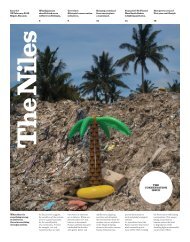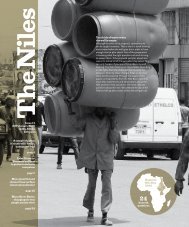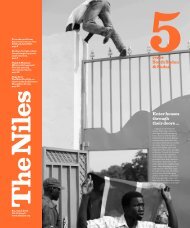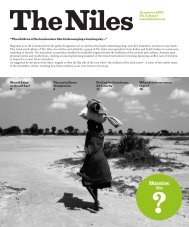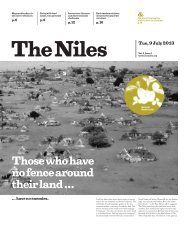When deeds speak, words are nothing
Speaking about sustainable development is easy. Acting sustainably is another matter. And now the evidence is unequivocal: Mankind’s impact on nature is causing the climate to change rapidly and drastically, threatening the environment and the very resources we need to survive. Aware that humanity is careening close to the edge, The Niles correspondents set out to explore where and how people in the Nile Basin region rethink. So much of their findings for now: We are an endlessly innovative species. Cooperation is our superpower. When deeds speak, words are nothing.
Speaking about sustainable development is easy. Acting sustainably is another matter. And now the evidence is unequivocal: Mankind’s impact on nature is causing the climate to change rapidly and drastically, threatening the environment and the very resources we need to survive. Aware that humanity is careening close to the edge, The Niles correspondents set out to explore where and how people in the Nile Basin region rethink. So much of their findings for now: We are an endlessly innovative species. Cooperation is our superpower. When deeds speak, words are nothing.
Create successful ePaper yourself
Turn your PDF publications into a flip-book with our unique Google optimized e-Paper software.
re<think
the way
we live
and work
24
“We urgently
need to change
the way we
do things.”
Mugisha said the current water supply is
sufficient to meet the Greater Kampala Metropolitan
Area needs over the next 10-15 years.
But with the ever-growing population of
Kampala city, which also serves as Uganda’s
commercial and industrial hub, it remains
to be seen whether this will remain the case.
For many urban planners in all Nile Basin
countries, the population explosion is a big
challenge for residents. As of September 1,
the real-time global data tracking website,
Worldmeter, puts Ethiopia’s current population
at 118 million, making it the most populous
country among the 11 Nile Basin countries.
Ethiopia is followed by Egypt (104.5 million),
DR Congo (93 million), Tanzania (60 million),
Kenya (53.7 million), Uganda (45.7 million),
Sudan (45 million). Rwanda (13.3 million),
Burundi (12.2 million), South Sudan (11 million)
and Eritrea (3.6 million).
Many of the people in these countries
live within the Nile Basin, with Egypt leading
at (85.5 million), followed by Ethiopia (37.6
million), Uganda (33.6 million), and Sudan
(31.4 million). Eritrea (2.2 million) and DR
Congo (2.9 million) have the smallest populations
within the Nile Basin.
Even more worrisome is the prediction
that the urban population in these countries
will shoot up in the coming decades. By 2050,
the urban population is expected to reach above
50 percent of the total population in four Nile
Basin riparian states. In seven countries, the
urban population will make up more than
40 percent of the total population. According
to the Nile Basin Water Resources Atlas, the
rural population is expected to shrink in all
countries rapidly.
Several experts The Niles has spoken to say
the complexity of the large number of countries
sharing the Nile Basin, combined with the uneven
distribution of the water resources among
these countries, population pressure and urbanisation,
pose significant challenges for the
sustainable management and development
of the shared resource.
Henry Bazira, the Executive Director
of the Water Governance Institute, a Kampalabased
non-profit, told The Niles that the rapid
population growth in all countries is putting
a lot of stress on the Nile waters.
Dr. Callist Tindimugaya, the Commissioner
for Water Resources Planning and Regulations
in Uganda’s Ministry of Water and Environment,
added that rising populations in countries like
Uganda, Burundi, Rwanda, Kenya and Tanzania
makes it harder to cover people’s basic needs.
“Take, for example, the issue of food. For
a long time, the upstream Nile Basin countries
have been depending on rain-fed agriculture
to grow food, but climate change means they
cannot depend on rainfall anymore. You now
need irrigation,” he said.
In addition, water was already in high
demand for people’s everyday needs at home
and for industrial uses. “That is why we are
saying we urgently need to change the way we
do things,” he told The Niles. “Without having
a rethink, conflicts will escalate.”
Climate change could intensify such conflict.
Ethan Coffel and Justin Mankin have written
about the potential risk that water scarcity in the
Nile Basin poses over the coming decades.
In their paper entitled “Future Hot and Dry
Years Worsen Nile Basin Water Scarcity despite
Projected Precipitation Increases”, Mankin,
an Assistant Professor at Dartmouth College and
Coffel, a Neukom Institute Postdoctoral Fellow
at the same college, noted that although there
is going to be more rain in the upstream countries,
there will be less water in the Nile.
That sounds like bad news for over 250
million people who are directly reliant on the
Nile waters in Ethiopia, Uganda, South Sudan,
Sudan and Egypt. At the moment, around 10
percent of the basin’s population faces chronic
water scarcity due to the region’s seasonal
aridity and the highly unequal distribution
of water resources.
By 2040, the researchers say a hot and dry
year could imply water scarcity for 45 percent
of people in the Nile Basin – nearly 110 million
people. But even without these developments,
the researchers say, population growth would
drive water scarcity in the upper Nile. But more
significant deficits in the amount of water into
streams and rivers during future hot and dry
years will amplify this effect.
The researchers’ findings agree with the 2020
Nile Basin Initiative (NBI) corporate report,
which notes that water availability per capita
in the Nile Basin declines. The report says the
Nile Basin countries need to explore new water
and use less water more efficiently.
Rethinking the Nile Basin’s water
security
The reality of the ever-dwindling water
volumes in the Nile is becoming more real
every passing day. Many experts are exploring
several ways of sharing the available water
in the Nile, among other avenues.
Egypt, a country that suffers perennial water
deficits, has explored the desalination of Red
Sea and the Mediterranean Sea water. Another
audacious alternative recently suggested is to
re-channel about 95 billion cubic metres of fresh
water from the Congo River to the Nile Basin.
Meanwhile, the NBI says it is embarking
on several projects and activities to increase
storage capacity.








